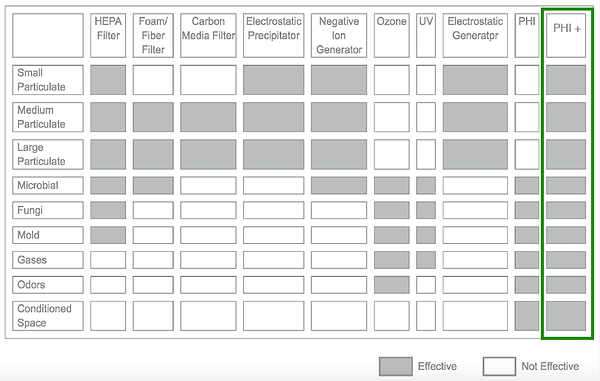
Tech comparison
This section contains quick explanations and criteria to help you decide what filtration method is best for a given problem. It familiarizes with the pros and cons for all the filtration and purification methods listed below. Filters are the most common filtration method. In general, filters must permit some pollutants to pass with the airflow. The higher the efficiency or density of the filter, the lower the airflow and higher the restriction to the blower.
HEPA Filters
DESCRIPTION: HEPA stands for high efficiency particulate air filter. HEPA filters utilize a powerful blower to force the air through a very tight membrane to achieve high efficiency particulate filtration.
PROS: They are very efficient in the filtering of air that passes through the filter. They filter to .03 micron.
CONS:
They require filter changes. The filter can act as a breeding ground for bacteria, mold and fungus. They do not remove odors, gases, pesticides, viruses and many bacteria. They reduce airflow due to the tight pores of the filter. They are generally not used in central systems, and sold as stand-alone units only.

Carbon Media Filters
DESCRIPTION: Carbon filters consist of carbon impregnated filter fabric or granulated carbon. These filters usually have a foam or fabric filter to hold the media. Carbon has the unique capability of acting as a physical filter trapping particulate, and on a chemical basis by reacting with some odors and some of the heavy gases.
PROS: Absorbs odor, absorbs some gases, filters particulate, installed in central or individual rooms.
CONS: Requires frequent changes, acts as a breeding ground for microorganisms, can easily become blinded and ceases functioning. They reduce airflow.

Fiber/Foam Filters
DESCRIPTION: Fiber or open-cell foam filters rely on the air passing through a matrix of foam cells or fibers of fiberglass, wire, plastic or cloth. Typically, these filters only stop medium to large particulate.
PROS: Low cost, low air resistance, installed in central units.
CONS: They only filter the air that passes through the filter. The particle build-up can act as a breeding ground for bacteria. They only filter medium to large particulate.

Electrostatic Precipitators
DESCRIPTION: Electrostatic Precipitators have been used by industry for many years to clean up smokestack emission of particulate. They operated by electrically charging a field between metal plates. The air is charged with an electrical charge similar to static electricity. The charged particulate collect and coagulate on a second set of charged plates where they build up and fall to a collection tray.
PROS: They are very effective on removing smoke from the air that passes through the filter. They do not reduce airflow as most other filters do. They can be installed in central units or in each room.
CONS: They require frequent cleaning. They only filter the air that passes through the filter. The particle build-up can act as a breeding ground for bacteria.

Negative Ion Generators
DESCRIPTION: Negative ion generators have been used by industry for years to remove particulates from the air and to neutralize the effects of excess positive ions. Negative ions are produced electrically and travel through the air until they attract airborne particulate and coagulate the particulates until they are too heavy to drift and settle to the floor.
PROS: They are very effective on removing smoke from the air. They travel throughout the entire room and purge all the air of particulate, not just the air that passes through a filter.
CONS: They drop the particulate to the ground. They must be in each room as the ions cannot effectively travel through HVAC ducts.

Ozone
DESCRIPTION: Ozone is a gas of oxygen-an oxygen molecule containing three atoms instead of two, like the oxygen we breathe. The extra atom of ozone is known as a loose radical that looks for organics to attach to and thereby oxidize. Ozone is known as a friendly oxidizer due to the fact that it reverts back to oxygen after oxidation occurs.
PROS: Ozone is an oxidizing gas that travels throughout the room and oxidizes all organics. Ozone can neutralize odors and gases. Ozone destroys microorganisms and does not reduce airflow. Ozone units can be installed in central units or in each room.
CONS: Ozone has no effect on particulate solid particles. Ozone exposure can be very dangerous at high levels.

Ultraviolet (UV) Light
DESCRIPTION: Ultraviolet light rays have been used as a sanitizer by the medical profession for years. Ultraviolet light can also sanitize air that is passed directly in its path with the proper exposure times.
PROS: Ultraviolet light can destroy bacteria, fungus, molds and some gases. It does not reduce airflow.
CONS: Ultraviolet light has no effect on particulate, needs direct close contact with acalculated exposure time, ultraviolet light rays must be shielded from human exposure. UV Light has little to no effect on the conditioned space.

Photohydroionization™
DESCRIPTION: An advanced oxidation technology patented by RGF utilizing broad spectrum HE/UV light targeted on a quad metallic target that produces Hydroperoxides that reduce microbes and gases in the conditioned space.
PROS: A broad scope of oxidizers makes it extremely effective on a larger number of microbes and gases.
CONS: Little effect on airborne particulate.

